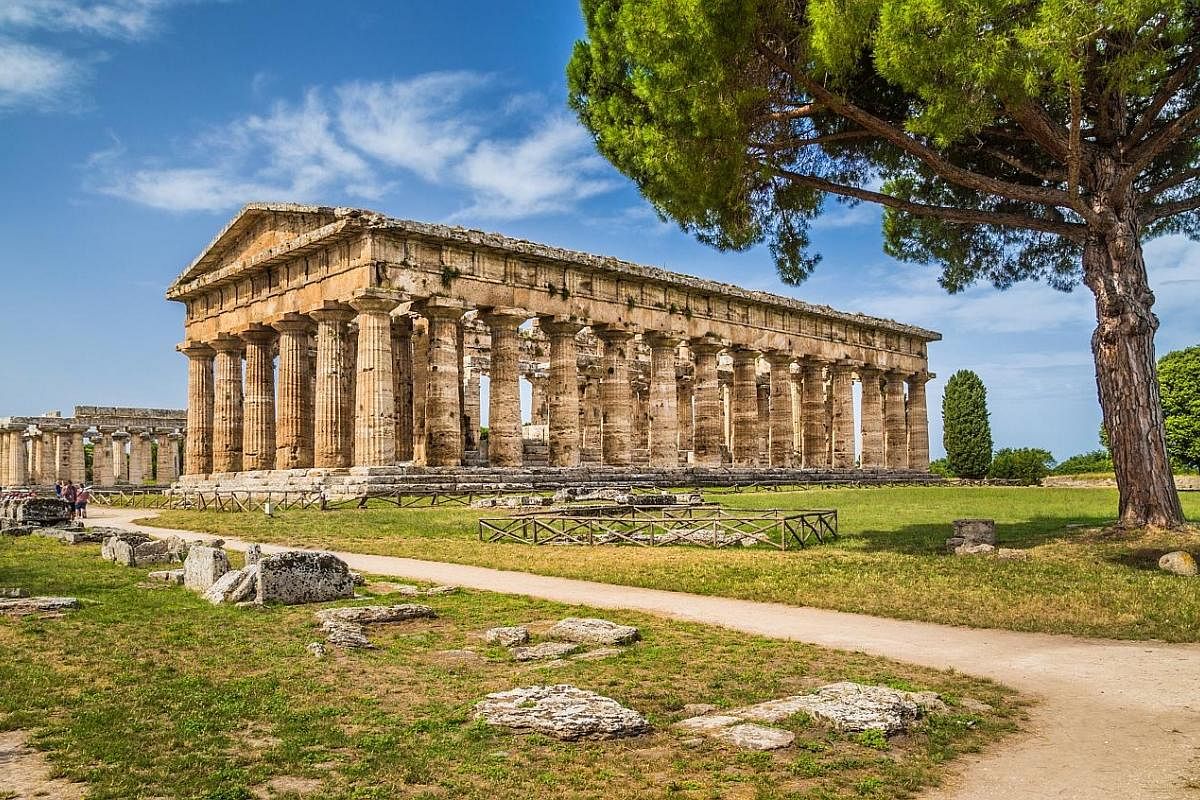-
GETTING THERE
-
From Singapore, it is best to fly into Naples International Airport, which is about an hour's drive or 11/2 hours by train from Salerno.
Singapore Airlines flies direct to Rome, where you can catch an Alitalia flight to Naples.
Swiss Airlines operates flights to Naples via Zurich and Turkish Airlines flies to Naples via Istanbul.
-
TIPS
-
• If you want to enjoy the relaxing atmosphere and get to know Cilento, allow at least five to seven days to explore it.
• As it is not on the typical tourist trail, it is quite difficult to find a good guide for Cilento, particularly one who speaks English. I recommend visiting websites such as www.summerinitaly.com and www.visitcilento.com for useful information.
• Tourism facilities and accommodation in Cilento veer towards the authentic, staying true to the surrounding environment, so do not expect luxurious suites or hotels with marble corridors. Of course, there are some fancy hotels, but they lose some of the region's rustic charm.
• Try not to plan everything in advance. When you get there, you will hear of amazing spots you did not know about that you will want to visit, or you will want to spend one more day in a town which has won your heart. Be flexible.
• People may not always speak English well, but in Salerno and the greater region of Cilento, hospitality is sacred. People are always cooperative and friendly.
• Salerno and the Cilento region are generally safe, but you should always take the necessary precautions.
Travel Black Book: Ambassadors series
Cilento: Italy's untouched gem
The best of home: Ambassadors to Singapore provide an insider's guide to their favourite destinations


Who: Mr Paolo Crudele, 52, Ambassador of Italy to Singapore
Favourite destination: Cilento is in a beautiful part of the Campania region in southern Italy. As is often the case in Italy, it is a place that has history, culture and amazing natural sights. About an hour's drive south of Naples, it is one of the rare pristine areas of the country that has yet to be touched by mass tourism.
From enjoying a laid-back afternoon on the white sands of Punta Licosa beach to losing yourself in the mediaeval alleys of Castellabate to tasting the world's most delicious mozzarella, which is produced in this area, Cilento has an incredible variety of things to see and do.
My hometown, Salerno, is the main city of Cilento and has many points of interest too.
SEE
When visiting Cilento, start in Salerno. Located in a beautiful gulf of the Tyrrhenian Sea, the city boasts a well-preserved historical centre, where the majestic Duomo is the highlight.
The 11th-century cathedral, with 17th-century Baroque and Rococo interiors, is said to be the most beautiful mediaeval church in Italy.
Art enthusiasts should also visit the Museo Pinacoteca Provinciale (tinyurl.com/y8xek4zv), which showcases paintings dating from the Renaissance period to the first half of the 20th century; and the archaeological museum (tinyurl.com/y9hw65n3), which houses artefacts dating back to the ancient cave dwellers and the colonising Greeks.
You can't miss Salerno's most famous landmark, the Castello di Arechi (www.ilcastellodiarechi.it), positioned above the city about 300m up the mountainside.
Originally a Byzantine fort, it was built in the eighth century. You can enjoy spectacular views of the Gulf of Salerno and the city rooftops.
Then, visit the town of Castellabate, which is a good base for exploring the rest of the region. It was built around the 12th-century Castle of the Abbot, which gives the town its name. Castellabate's old town has retained its mediaeval citadel aesthetic, with noble residences dating to the 17th century. Its highlight is the Church of Santa Maria de Gulia, which was built in the 12th century.
Nearby, Santa Maria di Castellabate is popular with tourists for its white-sand beaches, crystal-clear waters and picturesque cliffs overlooking the sea.
The neighbouring hamlet of Lago is particularly suitable for families, with excellent facilities, beaches and parks equipped for children.
From there, move on to what is my favourite cultural site, Paestum, just a few kilometres away. Before the birth of the Roman Empire, much of southern Italy was part of Magna Graecia (Great Greece) and was inhabited by Greeks.
A Unesco World Heritage site, Paestum was a major ancient Greek city and three of its Doric temples, dating from about 600 to 450BC, are among the most well-preserved in the world.
Because of its beautifully preserved art and architecture, it is one of the most important examples of Magna Graecia cities and is a hidden gem which should not be missed.
For a relaxing afternoon, I like to go to the seaside resorts of Palinuro or Marina di Camerota, which have some of the best beaches in Italy.
Capo Palinuro, a promontory jutting out into the sea, is one of the most beautiful stretches of coast in Campania, with its sheer cliffs dropping straight into the sea.
But its real treasures are its 32 underwater caves, which are a paradise for divers. The most prominent ones are the Blue Grotto, named for the spectacular play of light on the water, Silver Grotto and Sulphur Grotto. Non-divers can explore the caves via boat tours from the port of Palinuro.
Spend some time walking through the streets of Camerota in southern Cilento. With its fabulous architecture, the town bears the traces of the many cultures and empires which have ruled the region since the end of the Roman Empire, including the Bourbon dynasty, which ended with the unification of Italy.
For the best views, go to Trentinara near Paestum. This mediaeval village sitting on top of the Cantenna cliff 600m above sea level is also called "the terrace of Cilento".
You get one of the most stunning views of the region, from the vast plain of Sele, with the Paestum archaeological park in the distance, to the coast from the Gulf of Salerno to Punta Licosa and the beautiful island of Capri.
EAT
My favourite restaurant, the Tramp's Pub (tinyurl.com/ydhtjz9m), is in Salerno - a hidden gem outside the city's centre.
All of its delicious dishes are based on the catch of the day - which could include squid, cuttlefish, prawns, sea bass, sea bream, grouper, mullet and anchovies - so it is always a bit of a surprise to see what is available.
The service is friendly and prices reasonable - expect to pay €40 (S$62) to €50 a person, including wine.
Campania's white wines are exquisite. Try all the wines from the region, such as the Fiano, Falanghina and Greco di Tufo.
While touring the countryside, past rows of grape vines and olive trees, you may also see buffalo grazing in the hills. Their milk is turned into the most delicious mozzarella. It is undoubtedly the queen of local delicacies.
Visit one of the farms that produce mozzarella. Among the best and most famous in the region is Tenuta Vannulo (www.vannulo.it), a 200ha organic farm with 600 buffaloes. You can have lunch or dinner at its restaurant, take a guided tour of the farm and buy its handmade mozzarella, yogurt, ice cream and leather goods in the store.
PLAY
Travellers who like walking or hiking should explore the many hilltop trails in the National Park of Cilento (www.cilentoediano.it), one of Italy's largest national parks.
You can walk about 3km (about 2.5 hours) from the little harbour of Marina di Camerota to Grotta di Lentiscelle along an old mule track which suddenly presents breathtaking views of the sea.
Walking along silent bays and clefts, you will arrive at Punta Infreschi, one of the best small beaches in Italy that can be reached only on foot or by boat.
Like Cala Bianca, which was named Italy's most beautiful beach a few years ago, it is still a pristine, quiet spot, with few tourists and where nature has been preserved and people are open and friendly.
One of the best cultural sites of Cilento - which is sometimes overlooked by tourists because it is not often publicised - is the Charterhouse of Saint Lawrence in the town of Padula. The Unesco world heritage site is more than 450 years old and about an hour's drive from Salerno.
At more than 50,000 sq m, it is the largest monastery in Italy and has the biggest cloister in the world, surrounded by 84 columns and covering 12,000 sq m.
SHOP
I think the nicest shops and artisan workshops are found in the centre of Acciaroli.
This ancient fishing village is about a two-hour drive from Salerno and is one of the most precious jewels of the Cilento coast.
Traditional houses, narrow cobbled stone alleys, the intense perfume of flowers in the windowsills, long sandy beaches and a crystal-blue sea make it an oasis of peace and beauty. Here, you can buy beautiful handmade ceramics and carved wooden souvenirs.
STAY
The Palazzo Iaquinto in Santa Maria di Castellabate (tinyurl.com/y7tdqv2j) is located in the heart of Santa Maria di Castellabate and next to Marina Piccola beach.
Each apartment has sea-facing rooms, with views across the Gulf of Salerno towards the Amalfi coast, and comes with a bedroom, bathroom, kitchenette and refrigerator, and a living room with a sofa bed. Prices start at about $150 a night.
For something simpler, I recommend La Fattoria (tinyurl.com/ybhflyak), an agriturismo in the heart of the National Park of Cilento, with rooms, suites and fully equipped flats, a good-sized pool and easy access to nature walks or cycling trails. Depending on the time of year, room rates range from €35 to €50 a night.
Join ST's Telegram channel and get the latest breaking news delivered to you.
A version of this article appeared in the print edition of The Sunday Times on June 04, 2017, with the headline Cilento: Italy's untouched gem. Subscribe


